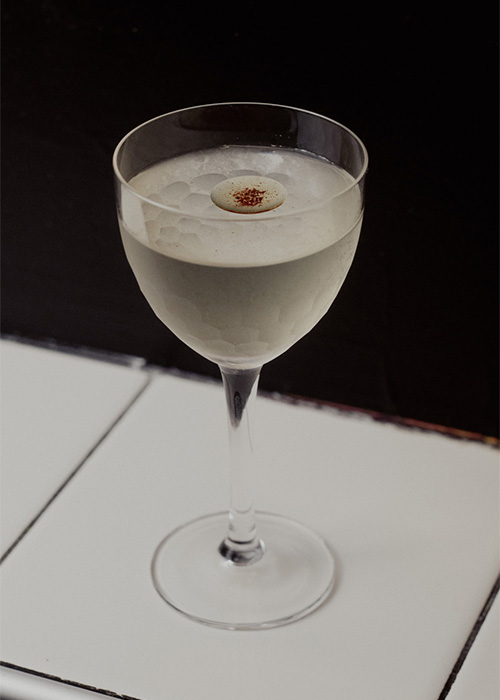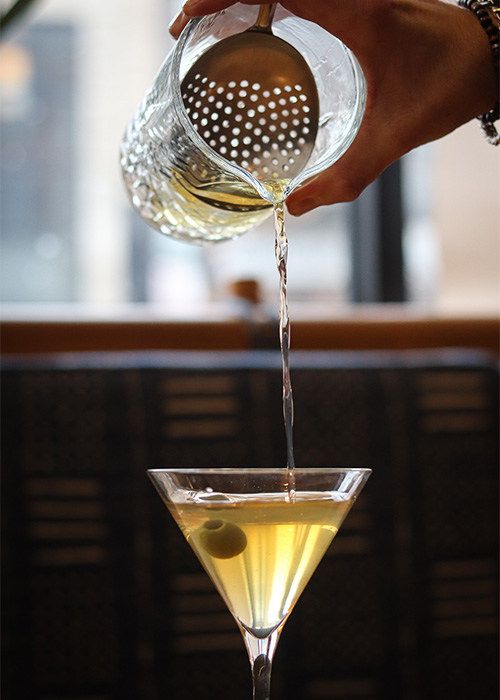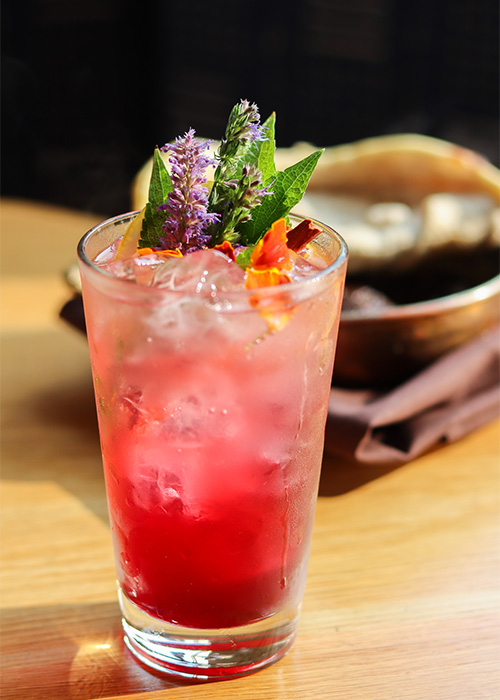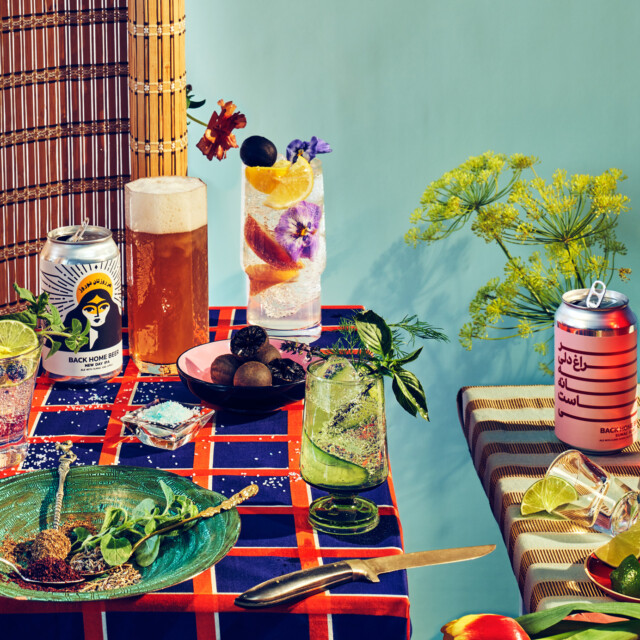When you’re planning a hot new Middle Eastern food pop-up, what’s your go-to cocktail?
For Kat Dean, operations director at the events company Please Bring Chips in Washington, D.C., the answer was obvious: a Za’atar Martini. A varied blend of herbs that usually contains oregano, thyme, sesame seeds, and the eponymous za’atar, or hyssop in Arabic, za’atar spice mix has become popular enough in recent years to warrant write-ups in mainstream newspapers and food magazines. But the cherished ingredient from the Middle East is not widely thought of as essential to a great Martini.

“I wanted to combine the smoothness of olive oil and the sharp flavor of za’atar,” Dean says. For balance, she infused the spice blend in Cocchi Americano instead of a normal dry vermouth. She washed the vodka in olive oil to add richness, then mimicked a pimento-stuffed olive with another drop of oil and a pinch of spice just before serving. “The garnish was a dollop of olive oil with a smidge of sumac in the center from a pipette,” she says.
Za’atar, sumac, and other flavors from the Middle East might be relatively familiar on the dinner plate, but they’re starting to find a starring role in the drinking glass as well. Many drinkers likely tried their very first Za’atar Martinis at the Palestinian food event that Please Bring Chips and Shabibi Chicken held in D.C., last month. But a few would have already tasted the cocktail at Maydan, a beloved local restaurant. Others might have sampled a Za’atar Martini at Galit in Chicago, at Tre Rivali in Milwaukee, or even overseas at Jefrey’s in Paris or at Gerard’s Bistro in Brisbane, Australia.
It’s part a global trend that goes way beyond spiced-up Martinis: The drinks world is riding a wave of Middle Eastern flavors, from Persian black lime in craft beers to unusual new gins from Lebanon. Bartenders, brewers, and distillers are using spices, spirits, fruits, herbs, and other Middle Eastern staples to brighten a number of classic recipes — and to create entirely new ones.
Middle East Home Flavors
Flavors from the Middle East have helped make the Brooklyn startup brewery Back Home Beer a standout, earning founder Zahra Tabatabai recent profiles in The Washington Post, among other publications, as well as VinePair’s 2022 Next Wave award for Brewer of the Year. For Tabatabai, brewing with Middle Eastern ingredients is a way to embrace her family’s Iranian heritage — and the “back home” flavors she loves.
“For me, it was something that was ingrained in my brain growing up, that my grandfather was making beer and wine in the garden, using things that he was growing and all these really cool, interesting flavors,” she says. “You see sumac and sour cherries or za’atar being used in food, but I really wanted to make the move into trying those flavors in alcoholic beverages.”
The result is an outside-of-the-box beer lineup based on ingredients from across the Middle East. In deference to her grandfather’s habit of putting salt in his beer, Tabatabai brews her Back Home Beer Persian Lager with blue salt from Iran. For her fruited Gose, a sour-salty beer style from Germany, Tabatabai uses Turkish cured sumac, a citrus-like spice, as well as more blue salt and a dose of sour cherries.
In a craft beer world that is often hyper-focused on hops, many drinkers are grateful to encounter different flavors, Tabatabai explains.
“I think everyone is just interested in something new, especially in an industry that has become a bit repetitive,” she says. “It’s something new in an environment where people are mostly drinking a lot of the same-tasting beers, with maybe a slightly different variation of hops.”
Tabatabai isn’t alone in adding Middle Eastern flavors to craft beer. Persian-style black lime is a key component of SeaQuench, a mass-market sour beer from Dogfish Head, while cult producer Scratch Brewing Company created its own Sumac Sour. Za’atar has found its way into pint glasses through Boulevard Brewing Company and Cambridge Brewing Company’s collaboration Za’Tart, as well as the Sumac & Za’atar Saison from the U.K.’s Partizan Brewing, both of which were cited as particularly food-friendly and appetite-stimulating by reviewers on beer rating apps.
Tabatabai thinks that’s exactly what Middle Eastern flavors are there for.
“I think that introducing new flavors and herbs and spices and fruits is just appealing to people’s palates,” she says. “They’re willing to try it and I’m thankful for that.”
A Strong Culinary Influence
Middle Eastern flavors might be a recognizable drinks trend, especially around Washington, D.C., but that wasn’t the case a decade ago. Chris Hassaan Francke ran his Middle East-inspired cocktail bar, the Green Zone, as a D.C. pop-up starting in 2014, before settling into a permanent location in 2018. Back in the early days, he says, there wasn’t a lot of competition.
“Nobody was doing cocktails with Middle Eastern flavors,” he says, speaking from his hotel room during a return trip to Iraq earlier this month. “There were Asian cocktails and South American cocktails, and God knows what. Everybody who had some kind of heritage or ethnic background was already doing something with cocktails, but nobody with a Middle Eastern background was doing it.”
Francke credits the earlier popularity of Middle Eastern cooking for today’s trend in drinks.
“I think it’s been the rise of Middle Eastern food in general. There’s been a huge spike in Middle Eastern restaurants that are trying to push the boundaries,” he says. “I’m not just talking about some aunt and uncle’s falafel shop. I’m talking about trained chefs who really want to expose their culture to the broadest audience possible.”

Many of those cooks, he says, are the children of immigrants from the Middle East, like himself, who came of age during a burgeoning culinary renaissance.
“We saw in the D.C. area, but also in the U.S. more generally, this massive explosion in food culture,” he says. “I think all of us, sort of around the same time, had the thought of, ‘All right, it’s time for our flavors to shine.’”
Scott Stroemer, the beverage director at Chicago’s Michelin-starred Galit, points to a similar connection between bar staff and kitchen workers, especially those making desserts.
“I think your first chef relationship is probably your pastry chef, because you use ingredients in much the same ways,” he says. “Your seasonal flavors are more the focus, as opposed to complementary.”
At Galit, touches from the Middle East are used to dress up classics — and even make a subtle nod to the career of chef Zachary Engel, who previously worked in New Orleans. For its Saz Arak — Galit’s version of a Sazerac — Stroemer uses rye whiskey, medjool date syrup, bitters, and arak, an anise-scented spirit that takes the role of absinthe in the traditional recipe.
“That was sort of a no-brainer. Sazarac is the most New Orleans cocktail ever,” he says. “It’s been on the menu since day one. Probably won’t ever change.”
Making Drinks With Middle Eastern Spices
Arak might not be absinthe, but other drinks from the Middle East will be more familiar to outsiders — even if they have a pronounced local touch. In addition to wines from the region, Galit serves Jun gin from Lebanon, which Stroemer describes as “very citrus-forward, as opposed to spice-forward.”
In fact, Lebanon is developing a real gin scene, with several distilleries working to incorporate the country’s native juniper, Juniperus excelsa, in addition to the Juniperus communis that is normally used in gin, as well as other local ingredients. Of the 22 botanicals in Lebanon’s Three Brothers Bathtub Gin, chief product officer Chadi Tannous notes, 21 actually come from Lebanon itself.
Other elements of Middle East drinking culture are even more sui generis, like the Tel Aviv-style gazoz drinks — refreshing, nonalcoholic, herb-and-spice seltzers — served at Galit.

Similar drinks from the region, Francke says, offer a framework for experiments.
“Obviously, the non-alcoholic drink culture is probably better developed in the Middle East than anywhere else,” he says. “A lot of that has inspired us. Some of the earliest cocktails I came up with were, ‘Oh, here’s this very well-known, non-alcoholic drink specialty from Lebanon, Iraq, Turkey, or wherever. Let me add some booze to it.’ That’s the easiest way to come up with a Middle Eastern cocktail.”
Drew Hairston, beverage director at D.C.’s Maydan, hails the tartness of many ingredients from the Middle East. A strong sumac and dried lemon infusion serves as the mixer for his drink, the Lebanese Blonde.
“It acts as the acid base of that cocktail,” he says. Conceived as a Lebanese-style take on Lynchburg Lemonade, the drink blends the sumac-lemon infusion with whiskey, Chareau aloe liqueur, and sugar. “You get these herbal, melon, eucalyptus, and aloe vera flavors, with the whiskey kind of rounding everything out,” he says.
Other bartenders have found new ways to incorporate these new flavors. While za’atar is clearly taking its star turn in the Martini, it also works in other drinks, according to Miguel Lancha, cocktail innovator for the José Andrés’s Group. He highlights that spice blend in a Margarita served at the two Zaytinya restaurants in New York and Washington, D.C.
“The way salt works in a Margarita was the drive for me to think about the za’atar spices working in it as well,” he says. In his recipe, Lancha combines za’atar spice mix with lime juice in a foam-like air, which is then layered on top of the Margarita before serving. That approach, he says, gives the drinker a consistent blast of spice in every sip.
When it comes to working with flavors from the Middle East, Stroemer has a few tips.
“You start with very basic stuff,” he says. “Here’s your spice blend. Let’s put it in a simple syrup and see where it goes. And then let’s infuse it into spirits and start playing around with that. Or let’s use it as just a simple garnish.” Rose water, hyssop water, and other liquid aromatics can be sprayed onto drinks with atomizers before serving. Spices can also work as a garnish. “One of the things I like to do is actually just dust the top of cocktails with aromatics, without actually working them into the cocktail,” Stroemer says.
For Lancha, less is sometimes more, especially when it comes to the strength of spice-forward drinks, though he prefers a cooking-like approach of several spices in combination rather than solos.
“Spices in this cuisine — like in most — are about playing nuances together,” he says. “I’d rarely work on a drink to showcase one spice or ingredient in particular, but rather a group of three or four. And in my experience, keeping the alcohol level low helps with Middle Eastern flavors.”
Bartenders should look out for regional variations in ingredients, Hairston says. His advice? Try a bunch of them.
“In Lebanon, the za’atar might have wild thyme, in Palestine it might not,” he says. “So look at the subtle differences and you can find some really cool flavors that you didn’t know were there.”
The Flavors Go Full Circle
While this might seem like an upcoming trend, producers point out that it echoes back to a long tradition of drinks in the Middle East — even the word alcohol comes from Arabic. Some of the earliest beers in history were made thousands of years ago in what is now Iran and Iraq, Tabatabai points out, while Iran’s Islamic Revolution only took place in 1978.
“For Iran in particular, they are ruled by Islamic law, but it’s only been that way for about 40 years,” she says. “There are thousands of years of history prior to that where people were drinking and making beer and making wine.”
For Francke, it’s worth bearing in mind that many people in the Middle East do drink alcohol today. Even his hotel in Iraq has a cocktail list, he notes during our call, though the drinks don’t seem to have a noticeable local influence.
“The fact is that there are plenty of people in the Middle East, whether they are Muslim or not, who do drink,” he says. “I’m at this hotel, and they have a bar, and they have a cocktail menu, and it’s all Western cocktails.”
That might be true — for now. As the Za’atar Martini and similar flavors spread across the globe, they’re getting closer to where they originally came from. Francke’s hotel in Iraq might not serve such recipes yet. But not too far away, the Dubai restaurant Qbara makes its Za’atar Martini with a house-infused za’atar gin, as well as a Margarita with preserved lemons, another Middle Eastern staple. And in nearby Oman, recent guest reviews suggest that the Za’atar Martini is the best drink you can order at the Alila Jabal Akhdar luxury resort.
Prop Styling: Maggie DiMarco
Food Styling: Thu Buser
